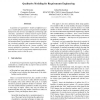Free Online Productivity Tools
i2Speak
i2Symbol
i2OCR
iTex2Img
iWeb2Print
iWeb2Shot
i2Type
iPdf2Split
iPdf2Merge
i2Bopomofo
i2Arabic
i2Style
i2Image
i2PDF
iLatex2Rtf
Sci2ools
SEW
2006
IEEE
2006
IEEE
Qualitative Modeling for Requirements Engineering
Acquisition of “quantitative” models of sufficient accuracy to enable effective analysis of requirements tradeoffs is hampered by the slowness and difficulty of obtaining sufficient data. “Qualitative” models, based on expert opinion, can be built quickly and therefore used earlier. Such qualitative models are nondeterminate which makes them hard to use for making categorical policy decisions over the model. The nondeterminacy of qualitative models can be tamed using “stochastic sampling” and “treatment learning”. These tools can quickly find and set the “master variables” that restrain qualitative simulations. Once tamed, qualitative modeling can be used in requirements engineering to assess more options, earlier in the life cycle.
| Added | 12 Jun 2010 |
| Updated | 12 Jun 2010 |
| Type | Conference |
| Year | 2006 |
| Where | SEW |
| Authors | Tim Menzies, Julian Richardson |
Comments (0)

